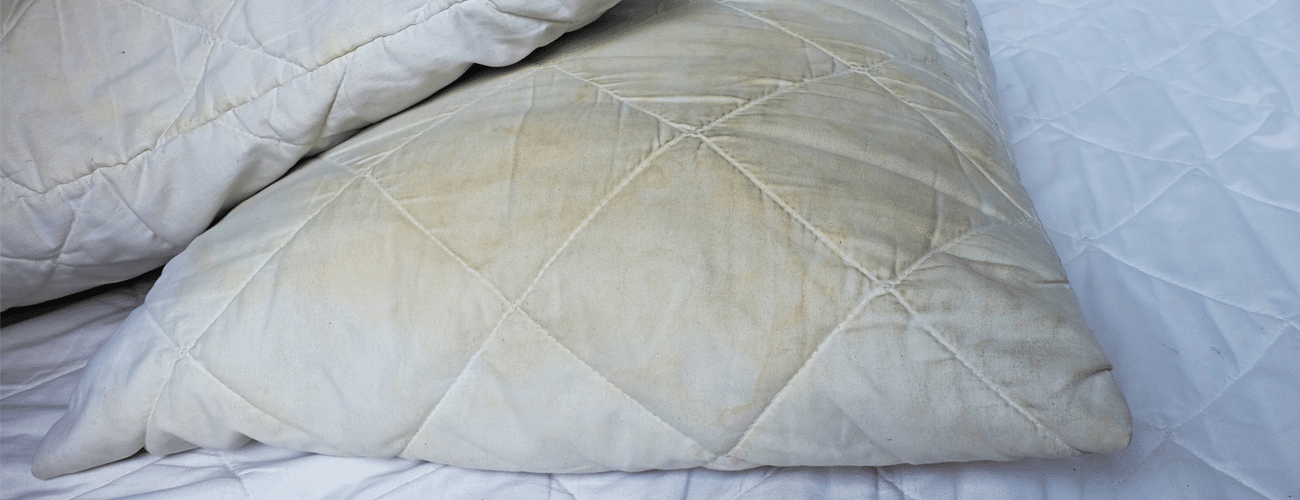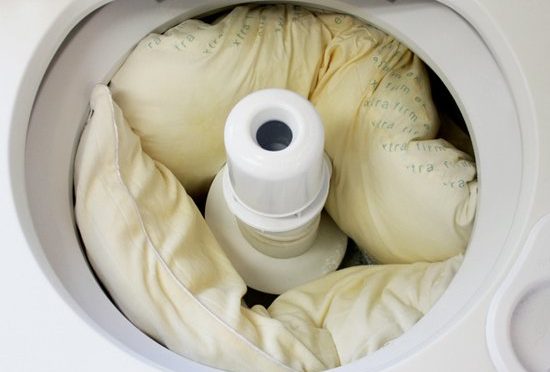Why Do Pillows Turn Yellow?
Is your pillow starting to spot or turn yellow?
Don't worry, we've all been there.
We spend an average of 7 hours a day sleeping, so it’s important we use hygienic pillows, or for those with bad allergies- hypoallergenic pillows.
But what if I told you that pillows have more bacteria than a toilet seat?
Why do pillows turn yellow with time? Why do they have all of these nasty bacteria? And how can you actually keep them clean? That’s what we’re about to find out!
Reasons Why Your Pillow Turns Yellow
If you think about it, simply laying your head on your pillow shouldn’t be a cause for its discoloration. So, let me tell you all the reasons why that happens.
1. Moisture
Moisture seeping into your pillow can cause evident changes of color over time.
Although sweating in your sleep is minimal, that doesn’t mean it doesn’t happen. Whether it’s the normal amount or you’re getting night sweats, that’s still moisture traveling onto your pillow.
There’s also wet hair that can soak up your pillow, not to mention drool. Drool is common, and it’s considered a sign that you’ve reached the deepest state of sleep.
2. Sun Exposure
It’s essential that your bedding is aired and exposed to the sun to get rid of dust mites and any pet hair that might be lying around.
However, direct, long exposure to the sun can cause the whites of your pillow to fade into an ugly shade of yellow. So, just don’t overdo it.
3. Skin and Hair Products
Applying skin and hair products overnight is a part of many people’s night routine. Although pampering yourself before bed can help you get better rest, these products can also end up being rubbed off into your pillows and sheets.
Similarly, sleeping with makeup on will end up with all of it accumulating as a layer of dirt on your pillow and may cause acne as well. If you feel your pillow is causing skin issues or breakouts, we recommend investing one of the top pillowcases for acne, which can help.
4. Body Oils and Dead Skin
Our bodies naturally make their own oils, which keep our skin soft and hair shiny. Unfortunately, the excess gets smeared into your pillow.
In addition, there is an average of 300,000 dead skin cells collecting in your bed every night.
This kind of dirt might not be noticed at first but it has a long-term effect.
5. Time and Oxidation
Exposure to oxygen over a long duration is, in other words, the wear and tear of time. That, and the constant washing and use of detergent, cause an inevitable breakdown of the fabric, no matter the quality of your pillow.

Some Simple Tips To Help Prevent Your Pillow From Turning Yellow Over Time
Now that we got the reasons for pillow yellowing out of the way, let’s see how we can prevent it from happening.
It’s alright to use hair products but use a headdress to ensure they don’t go onto your pillow. As for skin products, you can limit them to morning routines. And make sure to wash your face from any makeup before bed.
Make sure your room temperature isn’t too warm and that you don’t wear too many layers so you don’t end up sweating through the night.
A nice shower before bed is also a good idea to help you relax and fall asleep faster. However, make sure to dry your hair completely to avoid any persisting moisture.
Lastly, make sure you wash your pillows and pillowcases regularly.
What Happens If You Don’t Wash Your Pillowcases Regularly?
Yellow splotches aren’t the only concern that results from unclean pillows. Have you ever wondered why your allergies just get worse when you’re ready to sleep? That’s the massive amount of bacteria on your pillows making an appearance.
Not to mention, the sweat and dirt layered on your pillowcase could be the reason you’re suffering from acne. They could also be why you feel restless in bed.
How Many Times Should You Wash Your Pillows?
If you’re trying to keep your pillow from yellowing, a pillowcase is your first solution. It’ll protect your pillow, and it’s much easier to wash. Change the pillowcase at least once a week. If you’re prone to breakouts or skin irritation, try washing the pillowcase every day.
According to the Sleep Foundation, it’s recommended that you buy a new pillow every two years. Yet, if it’s in good shape and works well in supporting your neck and head, it can last longer than that.
Most pillows are washable, but you still check the label to make sure. You should wash it about twice a year so that it’s properly cleaned, yet it doesn’t lose its fluffiness.
How Do You Properly Wash Your Pillows?
If your pillows are washable, then your washing machine will do the job with ease. You can opt for the gentle cycle to avoid ruining the filling inside.
It’s recommended you go for two cycles so that the pillows are cleaned thoroughly. To add, use hot water to kill bacteria, bed bugs, and dust mites.
Use your usual detergent, preferably one that adds a refreshing smell to your pillow. However, don’t use a fabric softener as its residue can cause a chemical build-up that will affect the next washes.
Make sure you spot-treat any spots beforehand by using a stain removal spray. You can also try covering the yellowing parts with baking soda paste for half an hour.
If your pillow needs to be cleaned by hand, make sure you air your pillow first or vacuum-clean it. Then, you can soak it in hot water with vinegar and detergent. The vinegar will work as the fabric softener you need.
You can let the pillows dry naturally in the air, or you can dry them using your washing machine but add a couple of tennis balls to keep the filling from clumping.
Our Conclusion on Pillows Turning Yellow
There are many reasons why your pillow might be losing its fresh white look. It could be from natural body functions like drooling or sweating or it could be from products you use such as makeup, body lotion, or hair oils.
Either way, that means you have to up your maintenance game a bit. Proper care of your pillows will help you control your allergies and breakouts, too. You can do so by washing your pillow and pillowcases more often and avoiding the accumulation of dirt.

Hello! My name is James, a researcher of pillows and getting a great night’s sleep with over 10 years of experience! Graduate of the University of Kansas with a Physiology Degree. I enjoy writing, camping, reading, traveling abroad, swimming, and educational research. Contact me at the social links below!

